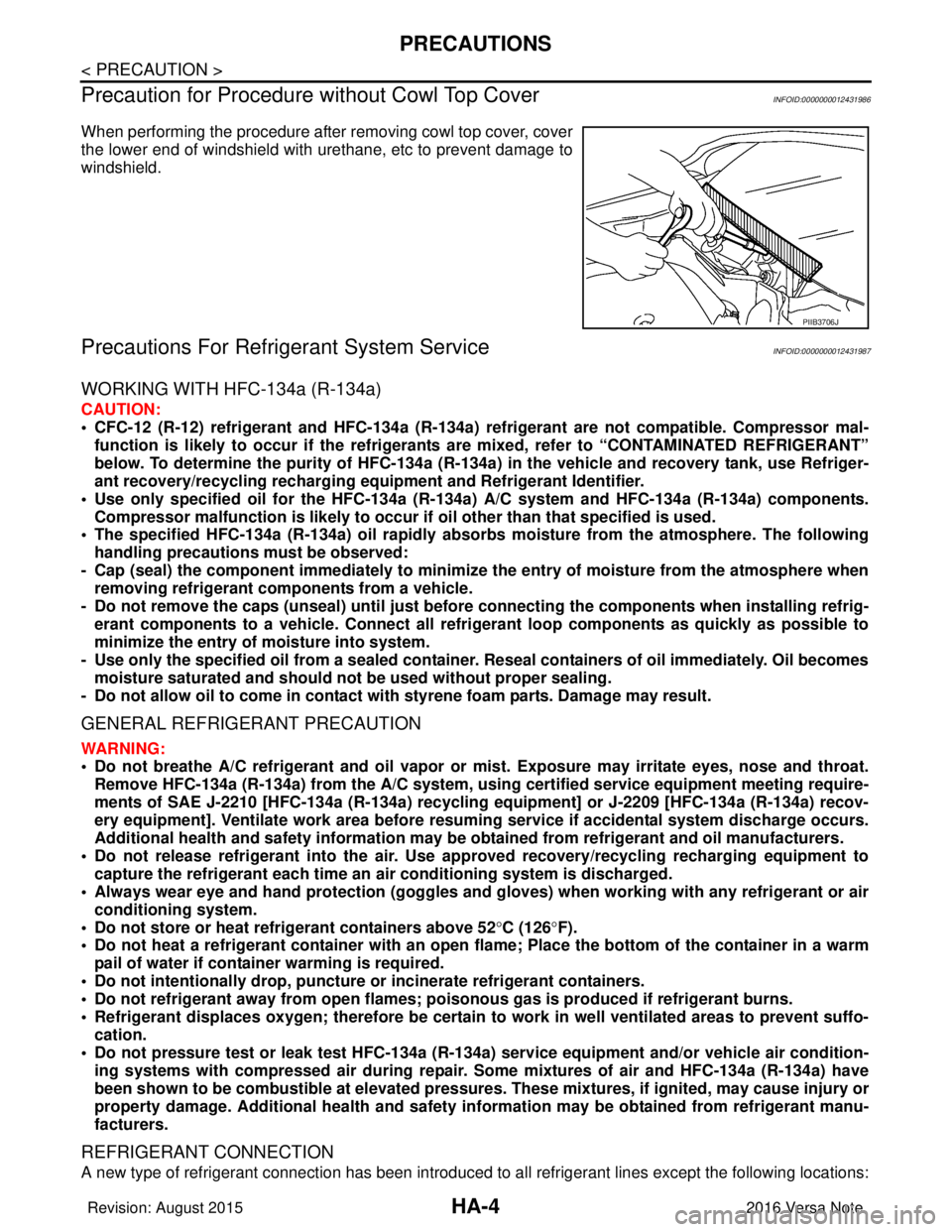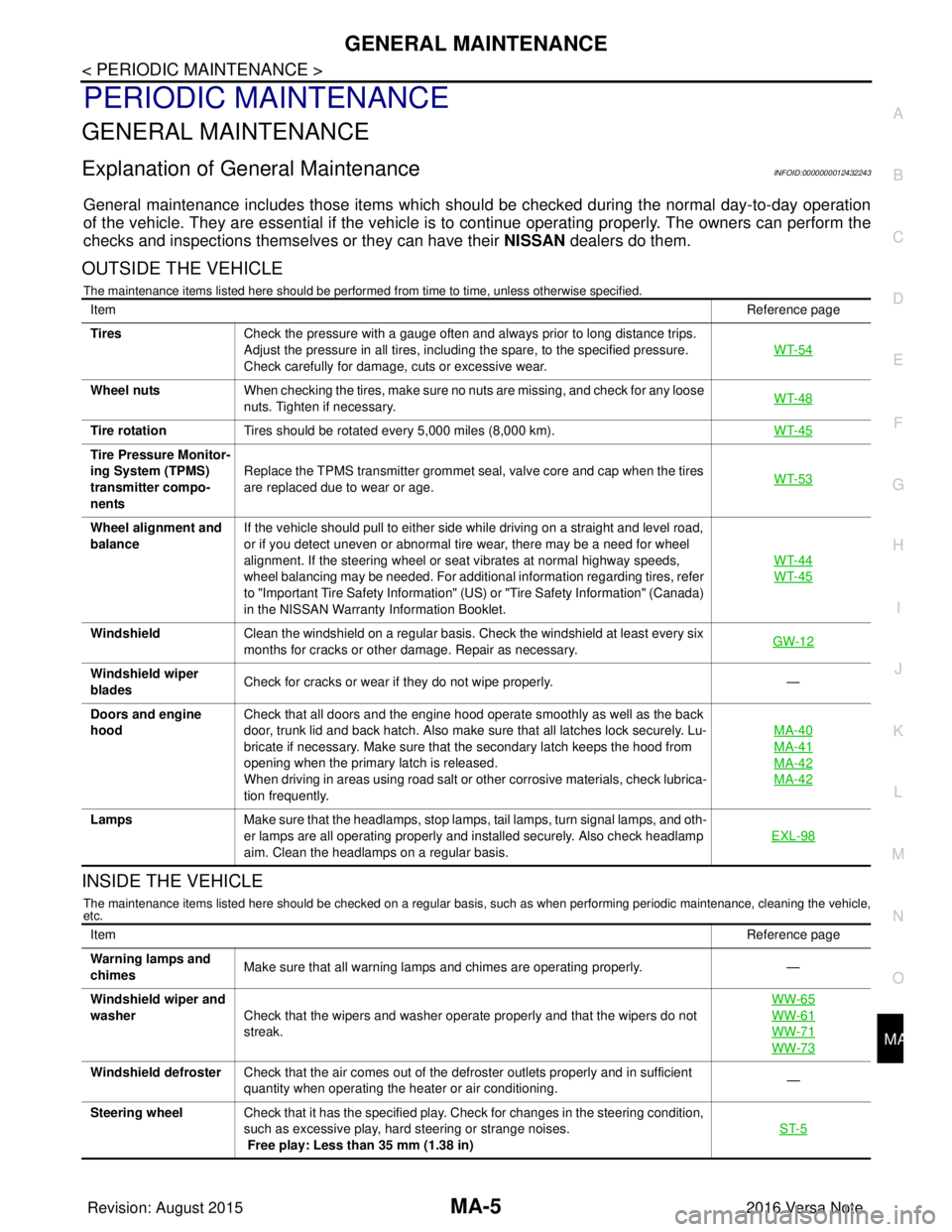2016 NISSAN NOTE air conditioning
[x] Cancel search: air conditioningPage 2021 of 3641
![NISSAN NOTE 2016 Service Repair Manual THERMO CONTROL AMPLIFIERHAC-53
< REMOVAL AND INSTALLATION > [MANUAL AIR CONDITIONING]
C
D
E
F
G H
J
K L
M A
B
HAC
N
O P
THERMO CONTROL AMPLIFIER
Removal and InstallationINFOID:0000000012430758
REMOVAL NISSAN NOTE 2016 Service Repair Manual THERMO CONTROL AMPLIFIERHAC-53
< REMOVAL AND INSTALLATION > [MANUAL AIR CONDITIONING]
C
D
E
F
G H
J
K L
M A
B
HAC
N
O P
THERMO CONTROL AMPLIFIER
Removal and InstallationINFOID:0000000012430758
REMOVAL](/manual-img/5/57363/w960_57363-2020.png)
THERMO CONTROL AMPLIFIERHAC-53
< REMOVAL AND INSTALLATION > [MANUAL AIR CONDITIONING]
C
D
E
F
G H
J
K L
M A
B
HAC
N
O P
THERMO CONTROL AMPLIFIER
Removal and InstallationINFOID:0000000012430758
REMOVAL
1. Remove evaporator. Refer to HA-35, "EVAPORATOR : Removal
and Installation".
2. Remove thermo control amplifier (1) from evaporator (2).
INSTALLATION
Installation is in the reverse order of removal.
CAUTION:
• Do not reuse O-rings.
• Apply A/C oil to new O-ring for installation.
• After charging refrigerant, check for leaks. Refer to HA-18, "
Leak Test".
ALIIA0921ZZ
Revision: August 2015 2016 Versa Note
cardiagn.com
Page 2022 of 3641
![NISSAN NOTE 2016 Service Repair Manual HAC-54
< REMOVAL AND INSTALLATION >[MANUAL AIR CONDITIONING]
REFRIGERANT PRESSURE SENSOR
REFRIGERANT PRESSURE SENSOR
Removal and InstallationINFOID:0000000012430759
CAUTION:
Perform lubricant return o NISSAN NOTE 2016 Service Repair Manual HAC-54
< REMOVAL AND INSTALLATION >[MANUAL AIR CONDITIONING]
REFRIGERANT PRESSURE SENSOR
REFRIGERANT PRESSURE SENSOR
Removal and InstallationINFOID:0000000012430759
CAUTION:
Perform lubricant return o](/manual-img/5/57363/w960_57363-2021.png)
HAC-54
< REMOVAL AND INSTALLATION >[MANUAL AIR CONDITIONING]
REFRIGERANT PRESSURE SENSOR
REFRIGERANT PRESSURE SENSOR
Removal and InstallationINFOID:0000000012430759
CAUTION:
Perform lubricant return operation before each A/C system disassembly. However, if a large amount of
refrigerant or lubricant leaks from the system, do no
t perform lubricant return operation. Refer to HA-
22, "Perform Oil Return Operation".
REMOVAL
1. Discharge the refrigerant. Refer to HA-20, "Recycle Refrigerant".
2. Remove front grille. Refer to EXT-32, "
Removal and Installation".
3. Remove upper air guide and air guide (LH). Refer to DLK-144, "
Exploded View".
4. Clean refrigerant pressure sensor and surrounding area. CAUTION:
Make sure to clean carefully.
5. Disconnect refrigerant pressure sensor harness connector.
6. Support liquid tank, then remove refrigerant pressure sensor (1). CAUTION:
• Be careful not to damage liquid tank.
• Be careful not to damage core surface of condenser.
• Cap or wrap the joint of the condenser and liquid tankwith suitable material such as vinyl tape to avoid the entry
of air.
INSTALLATION
Installation is in the reverse order of removal.
CAUTION:
• Do not reuse O-rings.
• Apply compressor oil to new O-ring of the refrigerant pressure sensor for installation.
• After charging refrigerant, check for leaks. Refer to HA-18, "
Leak Test".
ALIIA0004ZZ
Revision: August 2015 2016 Versa Note
cardiagn.com
Page 2023 of 3641
![NISSAN NOTE 2016 Service Repair Manual FRONT BLOWER MOTOR RESISTORHAC-55
< REMOVAL AND INSTALLATION > [MANUAL AIR CONDITIONING]
C
D
E
F
G H
J
K L
M A
B
HAC
N
O P
FRONT BLOWER MOTOR RESISTOR
Exploded ViewINFOID:0000000012430760
Removal and NISSAN NOTE 2016 Service Repair Manual FRONT BLOWER MOTOR RESISTORHAC-55
< REMOVAL AND INSTALLATION > [MANUAL AIR CONDITIONING]
C
D
E
F
G H
J
K L
M A
B
HAC
N
O P
FRONT BLOWER MOTOR RESISTOR
Exploded ViewINFOID:0000000012430760
Removal and](/manual-img/5/57363/w960_57363-2022.png)
FRONT BLOWER MOTOR RESISTORHAC-55
< REMOVAL AND INSTALLATION > [MANUAL AIR CONDITIONING]
C
D
E
F
G H
J
K L
M A
B
HAC
N
O P
FRONT BLOWER MOTOR RESISTOR
Exploded ViewINFOID:0000000012430760
Removal and InstallationINFOID:0000000012430761
REMOVAL
1. From under the LH side of the instrment panel, disconnect harness connector from front blower motor
resistor.
2. Remove screws and front blower motor resistor.
INSTALLATION
Installation is in the reverse order of removal.
1. Heating and cooling unit assembly 2. Front blower motor 3. Front blower motor resistor
AWIIA1465ZZ
Revision: August 2015 2016 Versa Note
cardiagn.com
Page 2024 of 3641
![NISSAN NOTE 2016 Service Repair Manual HAC-56
< REMOVAL AND INSTALLATION >[MANUAL AIR CONDITIONING]
DOOR CABLE
DOOR CABLE
Exploded ViewINFOID:0000000012430762
INTAKE DOOR CABLE
INTAKE DOOR CABLE : Removal and InstallationINFOID:00000000124 NISSAN NOTE 2016 Service Repair Manual HAC-56
< REMOVAL AND INSTALLATION >[MANUAL AIR CONDITIONING]
DOOR CABLE
DOOR CABLE
Exploded ViewINFOID:0000000012430762
INTAKE DOOR CABLE
INTAKE DOOR CABLE : Removal and InstallationINFOID:00000000124](/manual-img/5/57363/w960_57363-2023.png)
HAC-56
< REMOVAL AND INSTALLATION >[MANUAL AIR CONDITIONING]
DOOR CABLE
DOOR CABLE
Exploded ViewINFOID:0000000012430762
INTAKE DOOR CABLE
INTAKE DOOR CABLE : Removal and InstallationINFOID:0000000012430763
The intake door cable is not serviced separately. Refer to
HAC-52, "Removal and Installation".
INTAKE DOOR CABLE : AdjustmentINFOID:0000000012430764
1. Remove glove box assembly. Refer to IP-25, "Removal and Installation".
2. Disconnect intake door cable (1) from clip (A).
3. Set intake door lever to REC position.
4. Push intake door link (2) in the direction shown, then carefully pull outer cable to front air control side and connect clip.
1. Heating and cooling unit assembly 2. Plate 3. Air mix door linkage 2
4. Air mix door linkage 1 5. Air mix door cable6. Intake door lever
7. Intake door linkage 8. Intake door cable9. Foot door lever
10. Mode door cable 11. Main linkage12. Ventilator door rod
13. Ventilator door lever
A. To front air control
JMIIA1742ZZ
JMIIA0617ZZ
Revision: August 2015 2016 Versa Note
cardiagn.com
Page 2025 of 3641
![NISSAN NOTE 2016 Service Repair Manual DOOR CABLEHAC-57
< REMOVAL AND INSTALLATION > [MANUAL AIR CONDITIONING]
C
D
E
F
G H
J
K L
M A
B
HAC
N
O P
5. Operate intake door lever to make sure that inner cable moves smoothly. CAUTION:
When clipp NISSAN NOTE 2016 Service Repair Manual DOOR CABLEHAC-57
< REMOVAL AND INSTALLATION > [MANUAL AIR CONDITIONING]
C
D
E
F
G H
J
K L
M A
B
HAC
N
O P
5. Operate intake door lever to make sure that inner cable moves smoothly. CAUTION:
When clipp](/manual-img/5/57363/w960_57363-2024.png)
DOOR CABLEHAC-57
< REMOVAL AND INSTALLATION > [MANUAL AIR CONDITIONING]
C
D
E
F
G H
J
K L
M A
B
HAC
N
O P
5. Operate intake door lever to make sure that inner cable moves smoothly. CAUTION:
When clipping ou ter cable, do not move inner cable.
MODE DOOR CABLE
MODE DOOR CABLE : Re moval and InstallationINFOID:0000000012430765
The mode door cable is not serviced separately. Refer to HAC-52, "Removal and Installation".
MODE DOOR CABLE : AdjustmentINFOID:0000000012430766
1. Remove glove box assembly. Refer to IP-25, "Removal and Installation".
2. Disconnect mode door cable (1) from clip (A).
3. Set mode dial to VENT position.
4. Push main link (2) in the direction shown, then carefully pull outer cable to front air control side and connect clip.
5. Operate mode dial to make sure that inner cable moves smoothly. CAUTION:
When clipping ou ter cable, do not move inner cable.
AIR MIX DOOR CABLE
AIR MIX DOOR CABLE : Removal and InstallationINFOID:0000000012430767
The air mix door cable is not serviced separately. Refer to HAC-52, "Removal and Installation".
AIR MIX DOOR CABLE : AdjustmentINFOID:0000000012430768
1. Remove instrument lower panel LH. Refer to IP-24, "Removal and Installation".
2. Remove foot duct (LH). Refer to VTL-7, "
FOOT DUCT : Removal and Installation".
3. Disconnect air mix door cable (1) from clip (A).
4. Set temperature dial to full cold position.
5. Push air mix door link (2) in the direction shown, then carefully pull outer cable to front air control side and connect clip.
6. Operate temperature dial to make sure that inner cable moves smoothly. CAUTION:
When clipping ou ter cable, do not move inner cable.
JMIIA0618ZZ
JMIIA0619ZZ
Revision: August 2015 2016 Versa Note
cardiagn.com
Page 2026 of 3641

HA-1
VENTILATION, HEATER & AIR CONDITIONER
C
DE
F
G H
J
K L
M
SECTION HA
A
B
HA
N
O P
CONTENTS
HEATER & AIR CONDITIONING SYSTEM
PRECAUTION ....... ........................................3
PRECAUTIONS .............................................. .....3
Precaution for Supplemental Restraint System
(SRS) "AIR BAG" and "SEAT BELT PRE-TEN-
SIONER" ............................................................. ......
3
Precaution for Work ..................................................3
Precaution for Procedure without Cowl Top Cover ......4
Precautions For Refrigerant System Service ............4
Service Equipment .............................................. ......6
PREPARATION ............................................9
PREPARATION .............................................. .....9
Special Service Tool ........................................... ......9
Commercial Service Tool ..........................................9
Sealant and/or Oil ...................................................11
SYSTEM DESCRIPTION .............................12
COMPONENT PARTS ................................... ....12
Component Parts Location .................................. ....12
BASIC INSPECTION ...................................13
DIAGNOSIS AND REPAIR WORKFLOW ..... ....13
Workflow ............................................................. ....13
SYMPTOM DIAGNOSIS ..............................15
REFRIGERATION SYSTEM SYMPTOMS ..... ....15
Trouble Diagnosis For Unusual Pressure ........... ....15
Symptom Table .......................................................15
NOISE .................................................................17
Symptom Table ................................................... ....17
PERIODIC MAINTENANCE .........................18
REFRIGERANT .............................................. ....18
Description .......................................................... ....18
Leak Test ................................................................18
Recycle Refrigerant .................................................20
Charge Refrigerant .............................................. ....20
OIL .....................................................................22
Description ...............................................................22
Inspection ................................................................22
Perform Oil Return Operation ..................................22
Oil Adjusting Procedure for Components Replace-
ment Except Compressor .................................... ....
22
Oil Adjusting Procedure for Compressor Replace-
ment .........................................................................
23
PERFORMANCE TEST ....................................24
Inspection ................................................................24
REMOVAL AND INSTALLATION ...............26
COMPRESSOR .................................................26
Exploded View ..................................................... ....26
Removal and Installation .........................................26
Inspection ................................................................27
COOLER PIPE AND HOSE ..............................28
Exploded View .........................................................28
LOW-PRESSURE FLEXIBLE HOSE ..................... ....28
LOW-PRESSURE FLEXIBLE HOSE : Removal
and Installation ........................................................
28
HIGH-PRESSURE FLEXIBLE HOSE ........................29
HIGH-PRESSURE FLEXIBLE HOSE : Removal
and Installation .................................................... ....
29
HIGH-PRESSURE PIPE ............................................29
HIGH-PRESSURE PIPE : Removal and Installa-
tion ....................................................................... ....
29
CONDENSER ....................................................31
Exploded View .........................................................31
CONDENSER ......................................................... ....31
CONDENSER : Removal and Installation ...............31
LIQUID TANK ........................................................ ....32
Revision: August 2015 2016 Versa Note
cardiagn.com
Page 2029 of 3641

HA-4
< PRECAUTION >
PRECAUTIONS
Precaution for Procedure without Cowl Top Cover
INFOID:0000000012431986
When performing the procedure after removing cowl top cover, cover
the lower end of windshield with urethane, etc to prevent damage to
windshield.
Precautions For Refrigerant System ServiceINFOID:0000000012431987
WORKING WITH HFC-134a (R-134a)
CAUTION:
• CFC-12 (R-12) refrigerant and HFC-134a (R-134a) refrigerant are not compatible. Compressor mal-
function is likely to occur if the refrigerants are mixed, refe r to “CONTAMINATED REFRIGERANT”
below. To determine the purity of HFC-134a (R-134a) in the vehicle and recovery tank, use Refriger-
ant recovery/recycling recharging equi pment and Refrigerant Identifier.
• Use only specified oil for the HFC-134a (R-134a) A/C system and HFC-134a (R-134a) components.
Compressor malfunction is likely to occur if oil other than that specified is used.
• The specified HFC-134a (R-134a) oi l rapidly absorbs moisture from the atmosphere. The following
handling precautions must be observed:
- Cap (seal) the component immediately to minimize the entry of moisture from the atmosphere when removing refrigerant components from a vehicle.
- Do not remove the caps (unseal) unti l just before connecting the components when installing refrig-
erant components to a vehicle. Connect all refr igerant loop components as quickly as possible to
minimize the entry of moisture into system.
- Use only the specified oil from a sealed container. Reseal containers of oil immediately. Oil becomes
moisture saturated and should no t be used without proper sealing.
- Do not allow oil to come in contact with styrene foam parts. Damage may result.
GENERAL REFRIGERANT PRECAUTION
WARNING:
• Do not breathe A/C refrigerant and oil vapor or mist. Exposure may irritate eyes, nose and throat.
Remove HFC-134a (R-134a) from the A/C system, usin g certified service equipment meeting require-
ments of SAE J-2210 [HFC-134a (R-134a) recycling equipment] or J-2209 [HFC-134a (R-134a) recov-
ery equipment]. Ventilate work area before resumi ng service if accidental system discharge occurs.
Additional health and safety in formation may be obtained from refrigerant and oil manufacturers.
• Do not release refrigerant into the air. Use ap proved recovery/recycling recharging equipment to
capture the refrigerant each time an air conditioning system is discharged.
• Always wear eye and hand protection (goggles and gloves) when working with any refrigerant or air
conditioning system.
• Do not store or heat refrigerant containers above 52 °C (126° F).
• Do not heat a refrigerant containe r with an open flame; Place the bottom of the container in a warm
pail of water if container warming is required.
• Do not intentionally drop, puncture or incinerate refrigerant containers.
• Do not refrigerant away from op en flames; poisonous gas is produced if refrigerant burns.
• Refrigerant displaces oxygen; therefore be certain to work in well ventilated areas to prevent suffo- cation.
• Do not pressure test or leak test HFC-134a (R-134a) service equipment and/or vehicle air condition-
ing systems with compressed air during repair. Some mixtures of air and HFC-134a (R-134a) have
been shown to be combustible at elevated pressures. These mixtures, if ignited, may cause injury or
property damage. Additional heal th and safety information may be obtained from refrigerant manu-
facturers.
REFRIGERANT CONNECTION
A new type of refrigerant connection has been introduced to al l refrigerant lines except the following locations:
PIIB3706J
Revision: August 2015 2016 Versa Note
cardiagn.com
Page 2320 of 3641

GENERAL MAINTENANCEMA-5
< PERIODIC MAINTENANCE >
C
DE
F
G H
I
J
K L
M B
MA
N
O A
PERIODIC MAINTENANCE
GENERAL MAINTENANCE
Explanation of Gene
ral MaintenanceINFOID:0000000012432243
General maintenance includes those items which shoul d be checked during the normal day-to-day operation
of the vehicle. They are essential if the vehicle is to continue operati ng properly. The owners can perform the
checks and inspections themselves or they can have their NISSAN dealers do them.
OUTSIDE THE VEHICLE
The maintenance items listed here should be performed from time to time, unless otherwise specified.
INSIDE THE VEHICLE
The maintenance items listed here should be checked on a regular basis, such as when performing periodic maintenance, cleaning the vehicle,
etc.
Item Reference page
Tires Check the pressure with a gauge often and always prior to long distance trips.
Adjust the pressure in all tires, including the spare, to the specified pressure.
Check carefully for damage, cuts or excessive wear. WT-54
Wheel nuts
When checking the tires, make sure no nuts are missing, and check for any loose
nuts. Tighten if necessary. WT-48
Tire rotation
Tires should be rotated every 5,000 miles (8,000 km). WT-45
Tire Pressure Monitor-
ing System (TPMS)
transmitter compo-
nentsReplace the TPMS transmitter grommet seal, valve core and cap when the tires
are replaced due to wear or age.
WT-53
Wheel alignment and
balanceIf the vehicle should pull to either side while driving on a straight and level road,
or if you detect uneven or abnormal tire wear, there may be a need for wheel
alignment. If the steering wheel or seat vibrates at normal highway speeds,
wheel balancing may be needed. For additional information regarding tires, refer
to "Important Tire Safety Information" (US) or "Tire Safety Information" (Canada)
in the NISSAN Warranty
Information Booklet. WT-44
WT-45
Windshield
Clean the windshield on a regular basis. Check the windshield at least every six
months for cracks or other damage. Repair as necessary. GW-12
Windshield wiper
bladesCheck for cracks or wear if they do not wipe properly.
—
Doors and engine
hood Check that all doors and the engine hood operate smoothly as well as the back
door, trunk lid and back hatch. Also make sure that all latches lock securely. Lu-
bricate if necessary. Make sure that the secondary latch keeps the hood from
opening when the primary latch is released.
When driving in areas using road salt or other corrosive materials, check lubrica-
tion frequently. MA-40
MA-41
MA-42
MA-42
Lamps
Make sure that the headlamps, stop lamps, tail lamps, turn signal lamps, and oth-
er lamps are all operating properly and installed securely. Also check headlamp
aim. Clean the headlamps on a regular basis. EXL-98
Item
Reference page
Warning lamps and
chimes Make sure that all warning lamps and chimes are operating properly.
—
Windshield wiper and
washer Check that the wipers and washer operate properly and that the wipers do not
streak. WW-65
WW-61
WW-71
WW-73
Windshield defroster
Check that the air comes out of the defroster outlets properly and in sufficient
quantity when operating the heater or air conditioning. —
Steering wheel Check that it has the specified play. Check for changes in the steering condition,
such as excessive play, hard steering or strange noises.
Free play: Less than 35 mm (1.38 in) ST-5
Revision: August 2015
2016 Versa Note
cardiagn.com